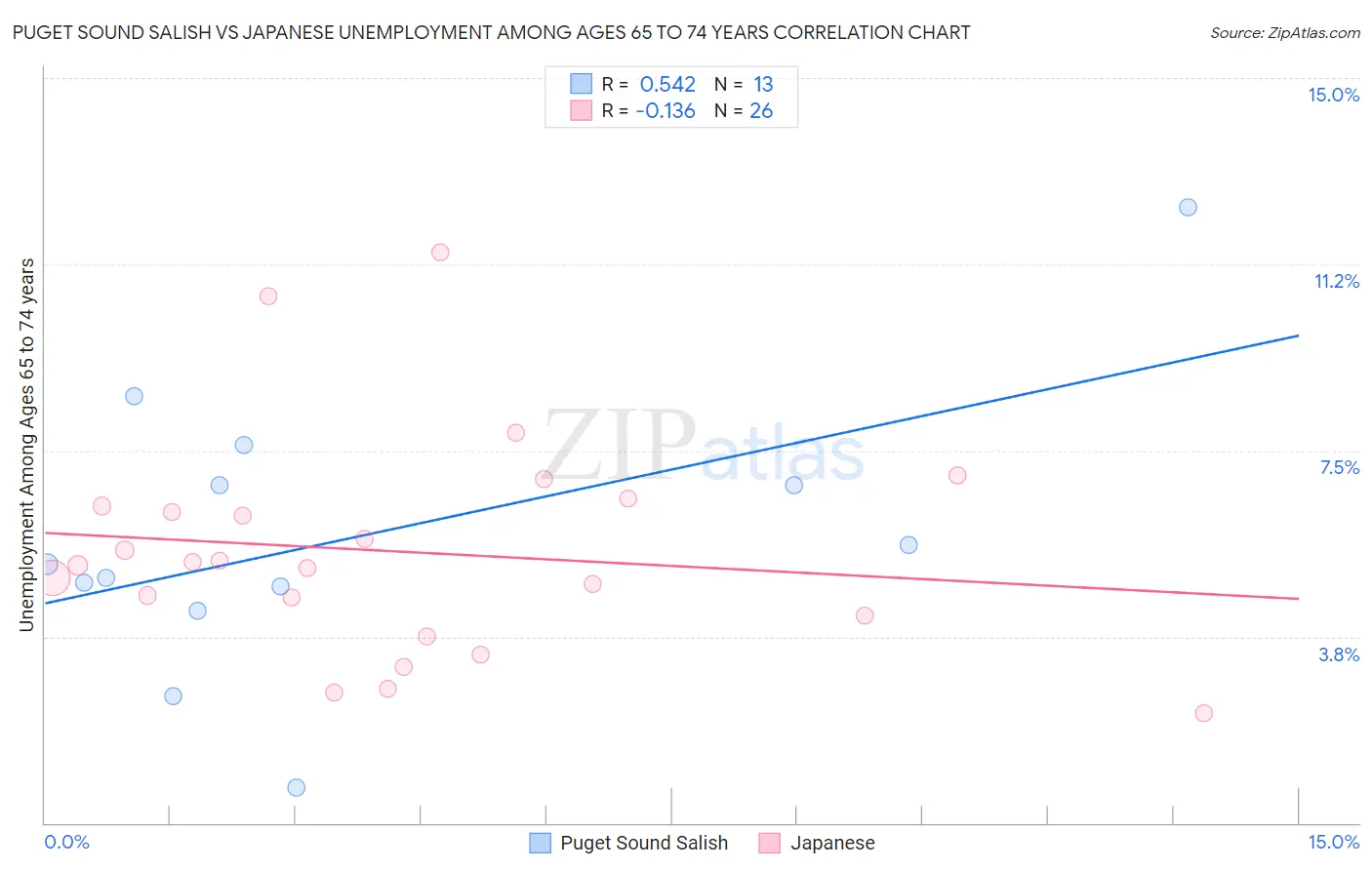Puget Sound Salish vs Japanese Unemployment Among Ages 65 to 74 years
COMPARE
Puget Sound Salish
Japanese
Unemployment Among Ages 65 to 74 years
Unemployment Among Ages 65 to 74 years Comparison
Puget Sound Salish
Japanese
5.2%
UNEMPLOYMENT AMONG AGES 65 TO 74 YEARS
97.3/ 100
METRIC RATING
92nd/ 347
METRIC RANK
5.2%
UNEMPLOYMENT AMONG AGES 65 TO 74 YEARS
96.4/ 100
METRIC RATING
100th/ 347
METRIC RANK
Puget Sound Salish vs Japanese Unemployment Among Ages 65 to 74 years Correlation Chart
The statistical analysis conducted on geographies consisting of 43,269,909 people shows a substantial positive correlation between the proportion of Puget Sound Salish and unemployment rate among population between the ages 65 and 74 in the United States with a correlation coefficient (R) of 0.542 and weighted average of 5.2%. Similarly, the statistical analysis conducted on geographies consisting of 230,153,386 people shows a poor negative correlation between the proportion of Japanese and unemployment rate among population between the ages 65 and 74 in the United States with a correlation coefficient (R) of -0.136 and weighted average of 5.2%, a difference of 0.26%.

Unemployment Among Ages 65 to 74 years Correlation Summary
| Measurement | Puget Sound Salish | Japanese |
| Minimum | 0.70% | 2.2% |
| Maximum | 12.4% | 11.5% |
| Range | 11.7% | 9.3% |
| Mean | 5.8% | 5.5% |
| Median | 5.2% | 5.2% |
| Interquartile 25% (IQ1) | 4.5% | 4.2% |
| Interquartile 75% (IQ3) | 7.2% | 6.4% |
| Interquartile Range (IQR) | 2.7% | 2.2% |
| Standard Deviation (Sample) | 2.9% | 2.2% |
| Standard Deviation (Population) | 2.8% | 2.1% |
Demographics Similar to Puget Sound Salish and Japanese by Unemployment Among Ages 65 to 74 years
In terms of unemployment among ages 65 to 74 years, the demographic groups most similar to Puget Sound Salish are Romanian (5.2%, a difference of 0.030%), Immigrants from Netherlands (5.2%, a difference of 0.060%), South African (5.2%, a difference of 0.080%), Serbian (5.2%, a difference of 0.080%), and Immigrants from Thailand (5.2%, a difference of 0.10%). Similarly, the demographic groups most similar to Japanese are Immigrants from Cambodia (5.2%, a difference of 0.0%), Burmese (5.2%, a difference of 0.020%), Welsh (5.2%, a difference of 0.030%), Senegalese (5.2%, a difference of 0.040%), and Immigrants from Lithuania (5.2%, a difference of 0.10%).
| Demographics | Rating | Rank | Unemployment Among Ages 65 to 74 years |
| Danes | 97.9 /100 | #86 | Exceptional 5.2% |
| Scottish | 97.9 /100 | #87 | Exceptional 5.2% |
| Immigrants | Saudi Arabia | 97.9 /100 | #88 | Exceptional 5.2% |
| English | 97.8 /100 | #89 | Exceptional 5.2% |
| Luxembourgers | 97.6 /100 | #90 | Exceptional 5.2% |
| Romanians | 97.4 /100 | #91 | Exceptional 5.2% |
| Puget Sound Salish | 97.3 /100 | #92 | Exceptional 5.2% |
| Immigrants | Netherlands | 97.1 /100 | #93 | Exceptional 5.2% |
| South Africans | 97.1 /100 | #94 | Exceptional 5.2% |
| Serbians | 97.0 /100 | #95 | Exceptional 5.2% |
| Immigrants | Thailand | 97.0 /100 | #96 | Exceptional 5.2% |
| Senegalese | 96.5 /100 | #97 | Exceptional 5.2% |
| Welsh | 96.5 /100 | #98 | Exceptional 5.2% |
| Burmese | 96.4 /100 | #99 | Exceptional 5.2% |
| Japanese | 96.4 /100 | #100 | Exceptional 5.2% |
| Immigrants | Cambodia | 96.3 /100 | #101 | Exceptional 5.2% |
| Immigrants | Lithuania | 95.9 /100 | #102 | Exceptional 5.2% |
| Immigrants | Vietnam | 95.6 /100 | #103 | Exceptional 5.2% |
| Yugoslavians | 95.5 /100 | #104 | Exceptional 5.2% |
| Iranians | 95.2 /100 | #105 | Exceptional 5.2% |
| Malaysians | 95.1 /100 | #106 | Exceptional 5.2% |